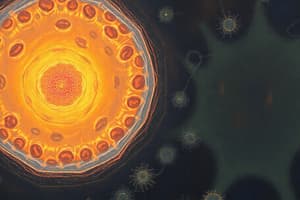Podcast
Questions and Answers
What is a distinguishing feature of Archaea compared to Bacteria?
What is a distinguishing feature of Archaea compared to Bacteria?
- Archaea typically thrive in low-oxygen environments. (correct)
- Archaea reproduce exclusively through sexual reproduction.
- Archaea are primarily aerobic organisms.
- Archaea have a cell wall made of peptidoglycan.
What is the primary function of the ribosome in eukaryotic cells?
What is the primary function of the ribosome in eukaryotic cells?
- Site of photosynthesis
- Site of protein synthesis (correct)
- Site of cellular respiration
- Site of genetic information storage
What is a characteristic of the cell membrane of Archaea?
What is a characteristic of the cell membrane of Archaea?
- Made exclusively of carbohydrates
- Contains fatty acids linked by ether bonds (correct)
- Composed of fatty acids linked by ester bonds
- Embedded with peptidoglycan
Which cell structure is responsible for the majority of eukaryotic energy production?
Which cell structure is responsible for the majority of eukaryotic energy production?
Which structure is commonly found in bacteria but not in archaea?
Which structure is commonly found in bacteria but not in archaea?
What is a significant evolutionary aspect of the mitochondria?
What is a significant evolutionary aspect of the mitochondria?
How do eukaryotic cells primarily differ from prokaryotic cells in terms of organization?
How do eukaryotic cells primarily differ from prokaryotic cells in terms of organization?
What is a function of chloroplasts in plant cells?
What is a function of chloroplasts in plant cells?
Flashcards are hidden until you start studying
Study Notes
What is a Cell? Unit of Life
- Cells are the basic structural and functional unit of life.
- Vary in size, with prokaryotic cells typically ranging from 0.5 to 8 μm.
Cell Structure
- Animal Cells: Complex and highly compartmentalized with organelles.
- Plant Cells: Similar to animal cells, with added components like a cell wall and chloroplasts.
- Bacteria: Simple structures, lacking membrane-bound organelles; often contain peptidoglycan cell walls.
Bacteria and Archaea
- Prokaryotic Domains: Consist of Bacteria and Archaea.
- Bacteria:
- Includes true bacteria and cyanobacteria (blue-green algae).
- Thrive in various environments, typically below 70°C.
- Exhibit metabolic diversity; can be aerobes or anaerobes.
- Archaea:
- Live in extreme conditions such as deep-sea vents and hot springs.
- Mostly anaerobic, thriving in low-oxygen environments.
- Metabolically distinct pathways support survival.
Differences Between Bacteria and Archaea
- Bacteria have membrane lipids linked by ester bonds; Archaea have ether bonds.
- Both reproduce asexually via budding, fission, and fragmentation.
Bacterial Structure
- Cytoplasm: Contains all cellular components.
- Nucleoid: Region where genetic material is located.
- Cell Membrane: Barrier controlling entry/exit of substances.
- Cell Wall: Composed of polysaccharides, mainly peptidoglycan.
- Additional structures may include an outer membrane, capsule, spores, flagella, and pili.
Eukaryotic Cells
- Highly organized with compartmentalization through membranes.
- Contain various organelles performing distinct functions.
Key Organelles
-
Nucleus:
- Enclosed by double membranes with nuclear pores.
- Contains the nucleolus and nucleoplasm.
- Holds the majority of genetic information in chromosomes.
-
Ribosomes:
- Serve as the site for protein synthesis.
- May be free in the cytoplasm or attached to membranes.
-
Endoplasmic Reticulum:
- Appears as a network of membranes, with incoming vesicles at the cis face and outgoing at the trans face.
-
Mitochondria:
- Site of aerobic respiration, producing most of the cell's energy.
- Contains two membranes and DNA of bacterial origin, indicative of evolutionary history.
-
Chloroplasts:
- Responsible for photosynthesis and contain chlorophyll.
- Comprise three membranes: inner, outer, and thylakoid space.
Evolutionary Insights
- Eukaryotic cells evolved to form complex structures with organelles, providing specialization in function and increased efficiency in cellular processes.
Studying That Suits You
Use AI to generate personalized quizzes and flashcards to suit your learning preferences.




